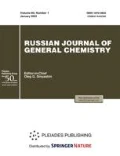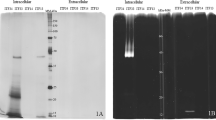Abstract
The antiwear and antitear properties of mycelial wastes from production of antibacterial antibiotics have been studied. The waste mycelium from fucidin production has been shown to exhibit the best antiwear and antitear performance due to a higher percentage content of phosphorus and sulfur as compared to the mycelial wastes from production of other antibacterial antibiotics.
Similar content being viewed by others
References
Okafor, N., Modern Industrial Microbiology and Biotechnology, Enfield: Science, 2007, pp. 429–454.
Mosier, N.S. and Ladisch, M.R., Modern Biotechnology: Connecting Innovations in Microbiology and Biochemistry to Engineering Fundamentals, Hoboken: Wiley, 2009, pp. 27–48.
Hook, D.J., Basic Biotechnology, Ratlendge, C. and Kristiansen, B., Eds., Cambridge: Cambridge Univ. Press, 2015, ch. 18, pp. 433–456.
Antibiotics: Current Innovations and Future Trends, Sanches, S. and Demain, A.L., Eds., Poole: Caister Academic, 2015.
Environmental Processes III, vol. 11C, Biotechnology: A Multi–Volume Comprehensive Treatise, Klein, J. and Winter, J., Eds., Weinheim: Willey, 2000, 2nd ed.
Environmental Biotechnology: Concepts and Applications, Jordening, H.-J. and Winter, J., Eds., Weinheim: Willey, 2005.
Gavrilesku, M., in Dynamic Biochemistry, Process Biotechnology, and Molecular Biology, Silva, J.A.T., Ed., Ikenobe (Japan): Global Science Books, 2010, pp. 1–36.
Viesturs, U.E., Smite, I.A., and Zilevica, A.V., Biotekhnologiya: Biologicheskie agenty, tekhnologiya, apparatura (Biotechnology: Biological Agents, Technology, Equipment), Riga: Zinatne, 1987, pp. 176–228.
Forster, C.F., in Environmental Biotechnology, Forster, C.F. and Wase, D.A.J., Eds., Chichester: Ellis Horwood, 1987.
Lancini, G. and Lorenzetti, R., Biotechnology of Antibiotics and Other Bioactive Microbial Metabolites, Berlin: Springer, 1993.
Belakhov, V.V. and Garabadzhiu, A.V., Russ. J. Gen. Chem., 2014, vol. 84, no. 13, p. 2664. doi 10.1134/S1070363214130271
Vinogradova, I.E., Protivoiznosnye prisadki k maslam (Antiwear Additives to Oils), Moscow: Khimiya, 1972.
Kuliev, A.M., Khimiya i tekhnologiya prisadok k maslam i toplivam (Chemistry and Technology of Additives to Oils and Fuels), Leningrad: Khimiya, 1985, pp. 100–138.
Shenin, Yu.D. and Belakhov, V.V., Antibiot. Khimioter., 1997, vol. 42, no. 4, pp. 34–46.
Armarego, W.L.F. and Chai, C.L.L., Purification of Laboratory Chemicals, Oxford: Butterworth-Heinemann, 2012.
GOST (State Standard) 9490–75: Liquid and Plastic Lubricating Oils: Method for Determination of Tribological Characteristics on a Four-Ball Wear Test System, 2008.
TU (Technical Specifications) 38.101523–80: Base Stock Oils Prepared by Selective Refining Process.
Kaplan, S.Z. and Radzevenchuk, I.F., Vyazkostnye prisadki i zagushchennye masla (Viscosity Modifiers and Thickened Oils), Leningrad: Khimiya, 1982.
Rudnick, L.R., Lubricant Additives: Chemistry and Applications, New York: CRC, 2010, 2nd ed.
Ahmed, N.S. and Nassar, A.M., in Lubricating Oil Additives, Tribology–Lubricants, and Lubrication, Kuo, C.-H., Ed., Rijeka: InTech, 2011, ch. 10, p. 249.
A Comprehensive Review of Lubricant Chemistry, Technology, Selection, and Design, Rizvi, S.Q.A., Ed., Baltimore: ASTM International, 2009, ch. 4, p. 100.
Anisimov, I.G., Badyshtova, K.M., and Bnatov, S.A., et al., Topliva, smazochnye materialy, tekhnicheskie zhidkosti. Assortiment i primenenie (Fuels, Lubricants, and Technical Liquids: Range and Application), Shkol’-nikov, V.M., Ed., Moscow: Tekhinform, 1999.
Caines, A.J., and Haycock, R.F., Automotive Lubricants Reference Book, London: Professional Engineering, 2004.
Zarubezhnye masla, smazki, prisadki, tekhnicheskie zhidkosti. Assortiment, svoistva, primenenie. Mezhdunarodnyi katalog (Foreign Oils, Lubricants, Additives, and Technical Liquids: Range, Properties, and Applications: Int. Catalog), Reznikov, V.D., Ed., Moscow: Tekhinform, 2005.
Rudnik, L.R., Prisadki k smazochnym maslam. Svoistva i primenenie (Lubricant Additives: Properties and Application), St. Petersburg: Professiya, 2013.
Author information
Authors and Affiliations
Corresponding author
Additional information
Original Russian Text © V.V. Belakhov, A.V. Garabadzhiu, 2016, published in Ekologicheskaya Khimiya, 2016, Vol. 25, No. 1, pp. 1–4.
Rights and permissions
About this article
Cite this article
Belakhov, V.V., Garabadzhiu, A.V. The application of mycelial wastes from microbiological production of antibacterial antibiotics as lubricating oil additives. Russ J Gen Chem 86, 2929–2932 (2016). https://doi.org/10.1134/S1070363216130016
Received:
Published:
Issue Date:
DOI: https://doi.org/10.1134/S1070363216130016




